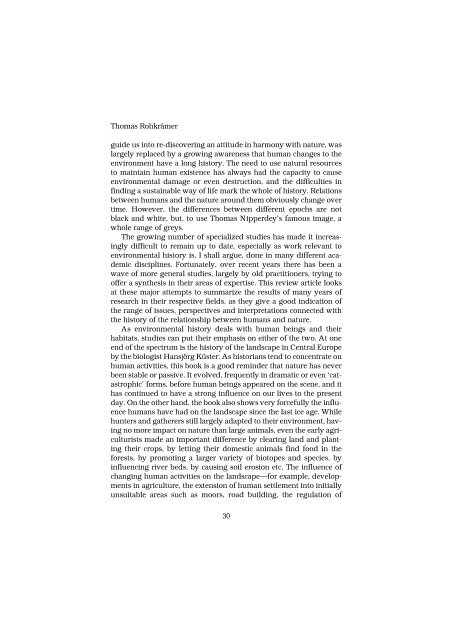Download - German Historical Institute London
Download - German Historical Institute London
Download - German Historical Institute London
Create successful ePaper yourself
Turn your PDF publications into a flip-book with our unique Google optimized e-Paper software.
Thomas Rohkrämer<br />
guide us into re-discovering an attitude in harmony with nature, was<br />
largely replaced by a growing awareness that human changes to the<br />
environment have a long history. The need to use natural resources<br />
to maintain human existence has always had the capacity to cause<br />
environmental damage or even destruction, and the difficulties in<br />
finding a sustainable way of life mark the whole of history. Relations<br />
between humans and the nature around them obviously change over<br />
time. However, the differences between different epochs are not<br />
black and white, but, to use Thomas Nipperdey’s famous image, a<br />
whole range of greys.<br />
The growing number of specialized studies has made it increasingly<br />
difficult to remain up to date, especially as work relevant to<br />
environmental history is, I shall argue, done in many different academic<br />
disciplines. Fortunately, over recent years there has been a<br />
wave of more general studies, largely by old practitioners, trying to<br />
offer a synthesis in their areas of expertise. This review article looks<br />
at these major attempts to summarize the results of many years of<br />
research in their respective fields, as they give a good indication of<br />
the range of issues, perspectives and interpretations connected with<br />
the history of the relationship between humans and nature.<br />
As environmental history deals with human beings and their<br />
habitats, studies can put their emphasis on either of the two. At one<br />
end of the spectrum is the history of the landscape in Central Europe<br />
by the biologist Hansjörg Küster. As historians tend to concentrate on<br />
human activities, this book is a good reminder that nature has never<br />
been stable or passive. It evolved, frequently in dramatic or even ‘catastrophic’<br />
forms, before human beings appeared on the scene, and it<br />
has continued to have a strong influence on our lives to the present<br />
day. On the other hand, the book also shows very forcefully the influence<br />
humans have had on the landscape since the last ice age. While<br />
hunters and gatherers still largely adapted to their environment, having<br />
no more impact on nature than large animals, even the early agriculturists<br />
made an important difference by clearing land and planting<br />
their crops, by letting their domestic animals find food in the<br />
forests, by promoting a larger variety of biotopes and species, by<br />
influencing river beds, by causing soil erosion etc. The influence of<br />
changing human activities on the landscape—for example, developments<br />
in agriculture, the extension of human settlement into initially<br />
unsuitable areas such as moors, road building, the regulation of<br />
30













